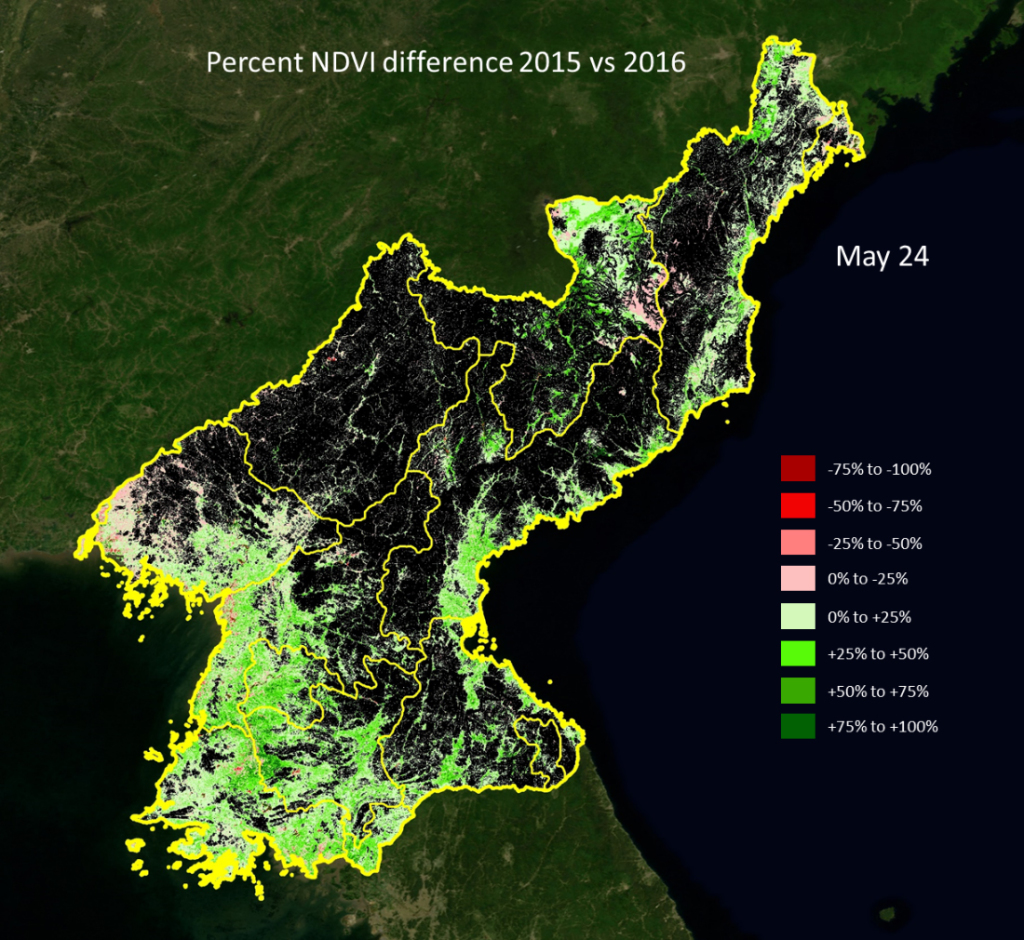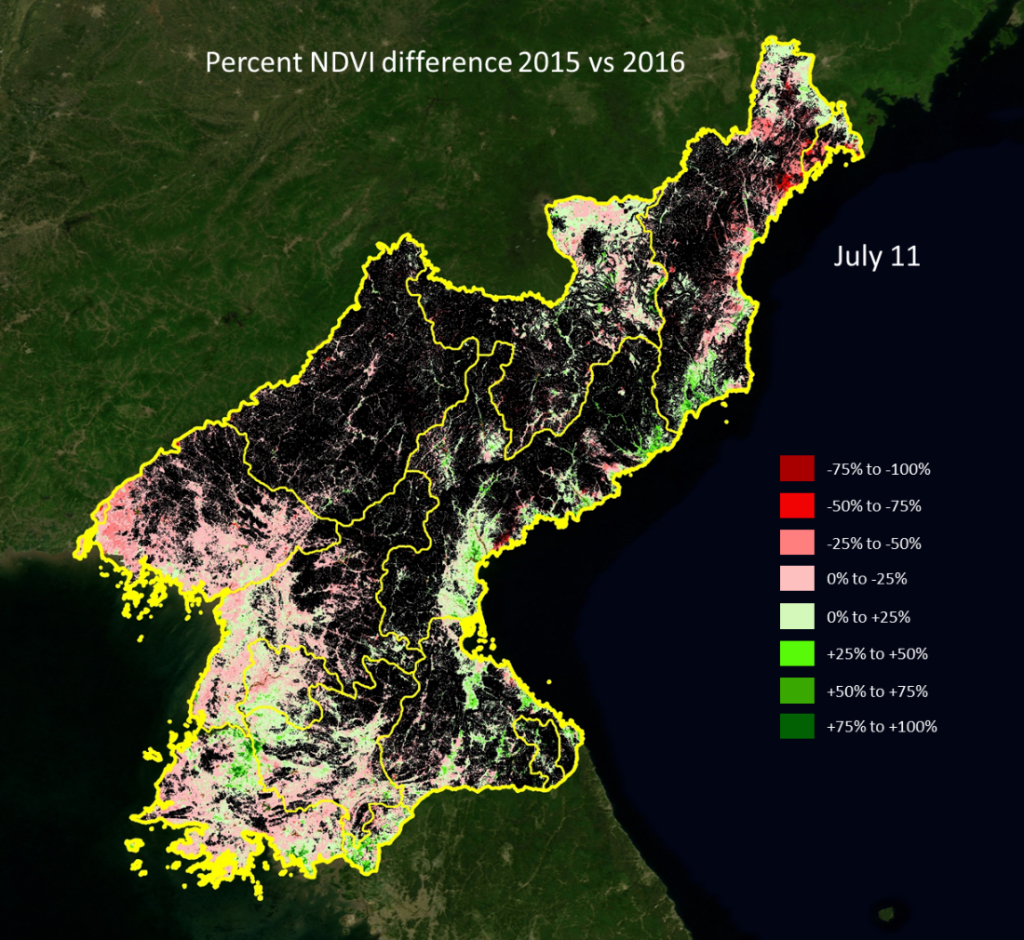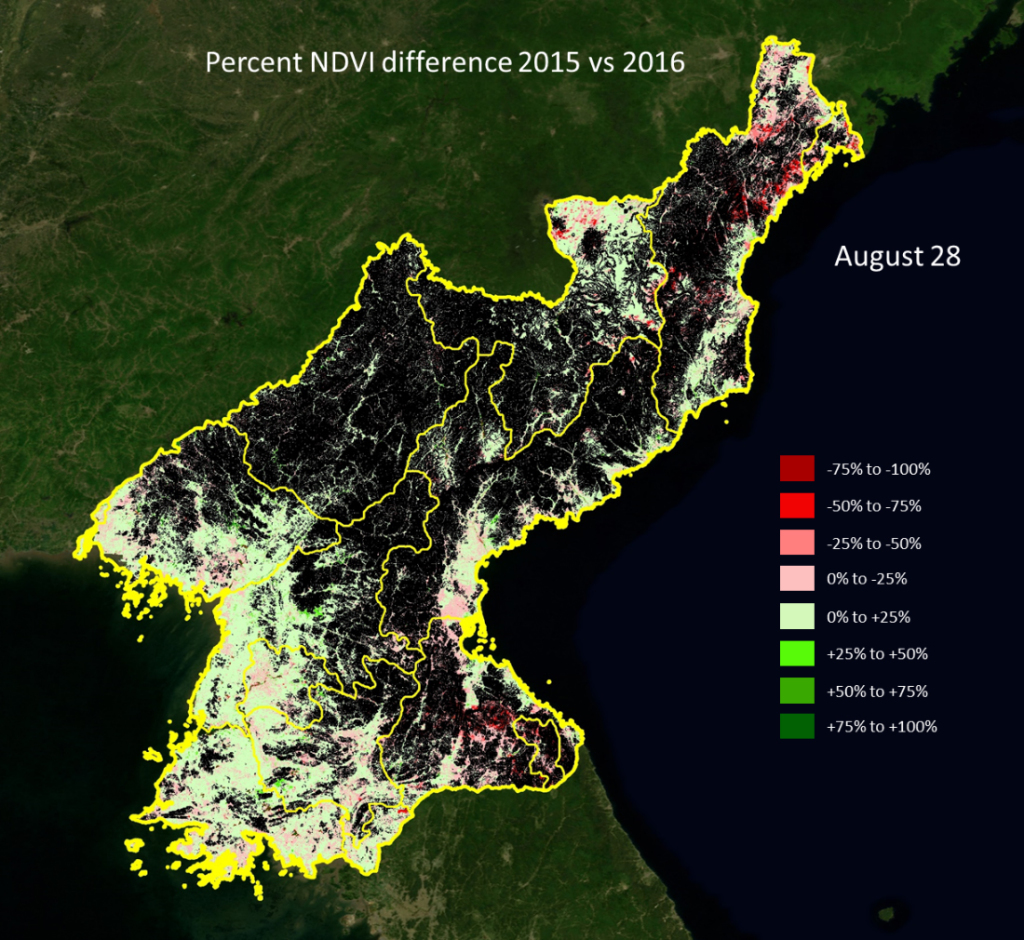Assessing Agricultural Conditions in North Korea: A Satellite Imagery Case Study
The Democratic People’s Republic of Korea (North Korea) continues to experience seasonal climate variations, drought conditions that greatly put its food production and supply at risk. Over the past several years, though food production remains generally higher compared to production output in the early 2000s, dry-weather patterns have negatively affected crop production by delaying planting and impacting crop growth during the growing seasons. The 2016 agricultural production year was no exception. Though the primary production areas of southwestern North Korea were doing well early, the northeastern provinces experienced drier conditions.
As described by Randall Ireson last year, North Korean agricultural production capabilities may have become more adaptive to localized, yearly weather variations. Satellite imagery is used by many organizations to assess global crop conditions as part of ongoing monitoring capabilities. For North Korea, satellite imagery can help identify indications of improved agricultural production management by monitoring crop conditions, but can also provide early indications of possible problems as well as insights into the North’s growing season challenges and the resiliency of the crop in response.
Evaluating crop management capabilities requires establishing a baseline of crop conditions and growing season calendar, and then monitoring general rainfall and temperatures to observe crop variations across the growing season in response to departures from normal. It also requires a direct comparison of previous years and resulting crop yields to assess the effectiveness of the crop management practices with regard to growing season conditions.
Figure 1. Comparison of NDVI for May 24 time frame.

For example, Figure 1 shows comparisons of May 24, 2016 versus 2015. The bright green areas show improved crop conditions from the previous year. It is not surprising to see the crop conditions are dramatically better in 2016 as the early sowing period of the growing season was quite dry in 2015 as compared to a more normal moisture pattern in 2016.[1] This means that the crops were able to emerge and begin to develop better in 2016, due to a more normal amount of precipitation. (Note: In this figure and subsequent figures, shades of green indicate improved crop conditions and shades of red indicate worse crop conditions for the same period of the growing season between 2015 and 2016. The black regions are areas where the terrain is too steep for significant agricultural production.)
Another example of how remote sensing data can be used to monitor agricultural production in North Korea is Figure 2, which shows changes for the July 11 monitoring period. The comparison of NDVI (normalized difference vegetation index) measurements between 2016 and 2015 for that period indicates a drop-off of crop health, which may be an early sign of stressful conditions that could result in a reduction of crop output. This sample time frame is early in the maturation period of crop development, when crop management and weather conditions may provide the means to overcome seasonal challenges. However, if dry conditions continue, predictions of yield reductions would be likely. To understand the likely outcome, this information would need to be evaluated in the context of each year’s growing season and conditions.
Figure 2. Comparison of NDVI for July 11 time frame.

Given the early growing season drought conditions of 2015 (before the July 11 time frame), it is unclear if this drop-off of crop health (represented by the increased amount of pinks and reds) indicates that the 2015 crops rebounded well or that the 2016 growing season was “later” in its timing. Due to weather conditions, the 2016 crops may have even begun to lag,[2] especially in the northeastern areas where the crop conditions appear to have fallen behind the 2015 crop status. For the northeast provinces, it is also unclear if this would indicate that food production could be hindered, and would be an area to watch through the remainder production season.
However, by late August (Figure 3), the northeast did not show much improvement. In this case, the crop production would appear to be reduced in 2016 from that of 2015. In contrast, the southwestern agriculture production areas appeared to have about average crop conditions into the late growing season. Several late summer typhoons brought moisture along the East Asian coasts, including the Korean peninsula. Since a significant portion of the crop production occurs there, this likely resulted in good production outputs for the region.
Figure 3. Comparison of NDVI for August 28 time frame.

While much of our understanding of North Korea’s agricultural production capabilities is derived from indirect information and observations, satellite imagery can be used to assess these capabilities as well as crop management adaptability. By monitoring weather conditions through the growing season, observing crop health and monitoring crops in challenging conditions, we can gain some insight as to the adaptability of the production capabilities of North Korea. In these figures, we see that crop production varied considerably from 2015 (somewhat expected), but that early indications for 2016 suggested that crop production was likely to result in favorable volumes of grain production.[3]
The importance of domestic agriculture and expanded production capabilities in the DPRK make it more challenging to understand the status of food security there. Building a baseline for crop production across average growing seasons can provide a framework where monitoring crop conditions will reveal characteristics of how well farmers are able to adapt and respond to drought and other significant impacts (such as the availability of irrigation and enhancements like fertilizers) to typical growing seasons and provide a better view of the true agricultural production capabilities of the DPRK.
———————-
[1] “DPR Korea: Drought—Jun 2015,” Reliefweb, June 2015.
[2] “North Korea’s Food Production Falls for First Time since 2010 as Water Scarcity Hits Agricultural Sector,” Food and Agriculture Organization of the United Nations, April 27, 2016.
[3] “GIEWS Country Brief: Democratic People’s Republic of Korea 16—June-2016,” Food and Agriculture Organization of the United Nations, June 16, 2016.
